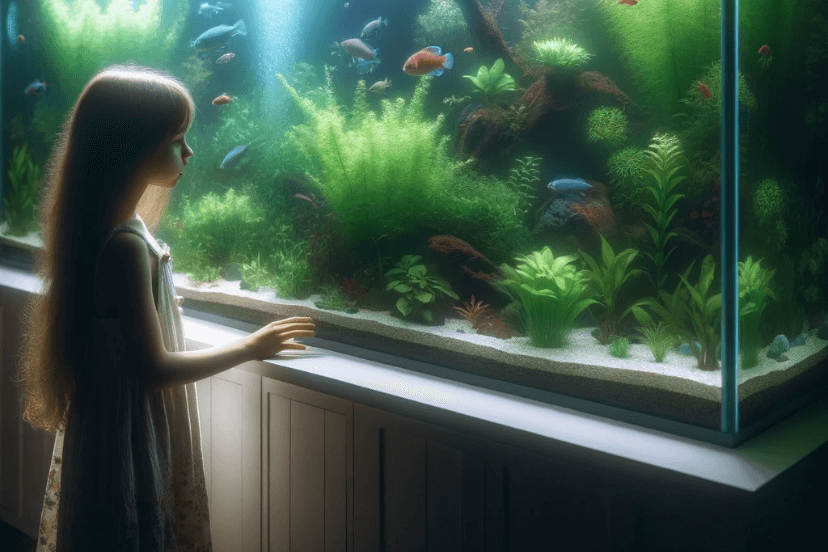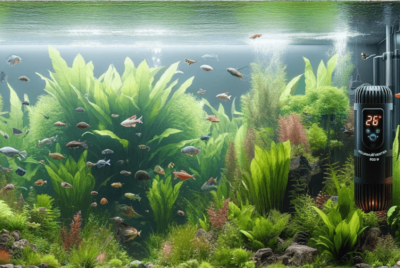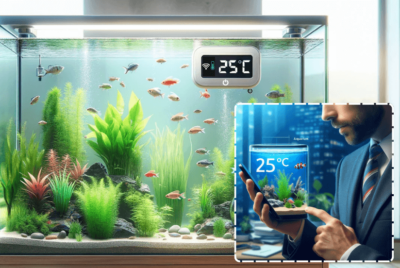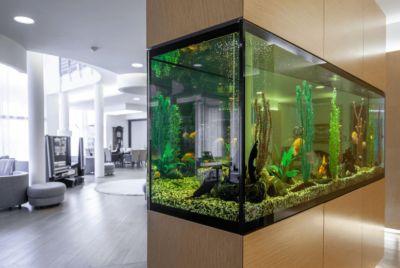Large Fish Tank Setup: Everything You Need to Know
Greetings, fellow aquarists! Are you prepared to immerse yourself in the exhilarating world of setting up a large fish tank? Well, you’ve landed in just the right spot because I’m here to accompany you through every phase of this captivating journey. From meticulously selecting the ideal tank size to cultivating a thriving aquatic ecosystem that dazzles the eye, consider me your trusted guide. Together, we’ll explore the intricacies of creating an underwater paradise that not only mesmerizes but also sustains a diverse array of aquatic life. So, let’s embark on this exciting adventure and transform your aquatic aspirations into breathtaking reality
Introduction to Large Fish Tank Setup
Setting up a large fish tank is not just a hobby; it’s a passion. The sheer size of these tanks allows for endless possibilities in terms of aquascaping and stocking. Whether you’re a beginner or a seasoned aquarist, there’s always something new to learn when it comes to large fish tank setups.
Benefits of Large Fish Tanks
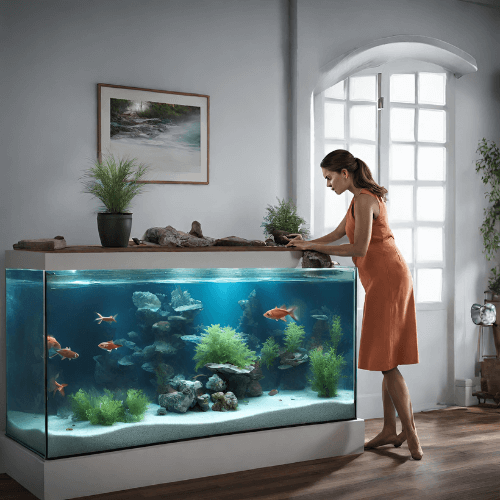
Let’s start by discussing why opting for a large fish tank is a great idea. Firstly, larger tanks provide more space for your fish to swim and explore, promoting their overall well-being. Secondly, the increased water volume helps maintain better water quality, reducing the frequency of water changes and minimizing stress on your aquatic pets. Lastly, large tanks are simply stunning to look at, adding a touch of elegance and serenity to any room.
More Space for Fish
Large fish tanks offer ample space for fish to swim and thrive. With more room to explore, fish exhibit natural behaviors, leading to healthier and happier aquatic inhabitants.
Better Water Quality
The increased volume of water in large fish tanks helps maintain superior water quality. With greater dilution of waste and toxins, coupled with efficient filtration systems, water parameters remain stable, reducing stress on fish and promoting optimal health.
Aesthetic Appeal
Large fish tanks serve as stunning focal points in any room. Their expansive size allows for intricate aquascaping, creating visually captivating underwater landscapes. Whether it’s a lush planted tank or a vibrant reef display, large tanks add elegance and tranquility to any space.
Samples of Larger Fish Tanks: Reef Tank vs. Planted Tank
When exploring larger fish tanks, two popular options are reef tanks and planted tanks. Reef tanks feature stunning coral formations, creating vibrant underwater ecosystems teeming with marine life. On the other hand, planted tanks showcase lush aquatic vegetation, providing a natural habitat for fish to thrive.
Reef tanks offer a dazzling display of colors, with corals ranging from vibrant reds to striking blues. These tanks require careful maintenance to ensure optimal water quality and lighting conditions for coral growth. In contrast, planted tanks focus on freshwater flora, offering a tranquil environment for fish to swim among lush greenery. Maintaining proper CO2 levels and nutrient balance is crucial for the health of aquatic plants in these tanks. Whether you’re drawn to the vibrant marine life of a reef tank or the serene beauty of a planted tank, both options provide ample opportunities for creating captivating large fish tank setups.
Choosing the Right Tank

When it comes to selecting the right tank for your setup, there are a few factors to consider. Glass and acrylic tanks are the two main options, each with its own set of pros and cons. Glass tanks are sturdy and scratch-resistant, while acrylic tanks are lighter and offer better clarity. Additionally, consider the size and placement of your tank, ensuring it fits seamlessly into your living space and can support its weight when filled with water and decorations.
Glass vs. Acrylic Tanks
When it comes to choosing a tank for your aquarium, you’ll typically encounter two main options: glass and acrylic. Glass tanks are favored for their durability and scratch-resistant nature, making them ideal for setups intended to last a long time. Meanwhile, acrylic tanks are lighter and boast better clarity, offering a clearer view of your underwater world. When making your decision, take into account your budget, the size of the tank you need, and your personal preferences.
Tank Size and Placement
When selecting a tank, consider both its size and placement within your home. Tank size plays a crucial role in the health and well-being of fish in aquariums. Larger tanks provide more space for fish to swim and explore, reducing stress and aggression. They also offer greater stability in water parameters, diluting waste and toxins more effectively. Research shows that fish in larger tanks exhibit more natural behaviors and have lower mortality rates compared to those in smaller tanks. Therefore, choosing an appropriately sized tank is essential for maintaining a thriving aquatic ecosystem.
Additionally, ensure that the chosen location can support the weight of the tank when filled with water and decorations. Avoid placing tanks in direct sunlight to prevent algae growth and temperature fluctuations. Choose a spot that enhances the aesthetic appeal of your aquarium while allowing for easy access for maintenance tasks.
Essential Equipment
Now that you’ve chosen your tank, it’s time to gather the necessary equipment. A reliable filtration system is essential for maintaining a healthy aquatic environment by removing debris and toxins from the water. Heating and lighting are also crucial for replicating natural conditions and supporting the growth of fish and plants. Don’t forget about other accessories like pumps, heaters, and decorations to complete your setup.
Filtration Systems
Filtration is essential for maintaining water quality in your large fish tank. There are various types of filtration systems available, including mechanical, biological, and chemical filters. Mechanical filters remove debris and particles from the water, while biological filters break down harmful ammonia and nitrites. Chemical filters help remove impurities and odors. Choose a filtration system based on the size of your tank and the needs of your aquatic inhabitants.
Heating and Lighting
Proper heating and lighting are crucial for creating a healthy environment in your large fish tank. Tropical fish species require stable water temperatures within a specific range, which can be achieved with aquarium heaters. Lighting plays a key role in promoting plant growth and showcasing the beauty of your aquatic ecosystem. LED lights are energy-efficient and offer customizable options for creating natural lighting effects.
Other Necessary Accessories
In addition to filtration, heating, and lighting, there are other accessories that are essential for maintaining your large fish tank. These may include aeration systems to increase oxygen levels in the water, water conditioners to remove chlorine and chloramines, and a quality test kit to monitor water parameters. Decorations such as rocks, driftwood, and plants not only enhance the aesthetic appeal of your tank but also provide hiding spots and territories for your fish. Consider the specific needs of your aquatic inhabitants when selecting accessories for your tank setup.
Setting Up Your Tank

With all your equipment in hand, it’s time to set up your tank. Start by adding a layer of substrate to the bottom of the tank, followed by any decorations or plants you wish to include. Next, fill the tank with water, making sure to use a dechlorinator to remove any harmful chemicals. Finally, kickstart the nitrogen cycle by introducing beneficial bacteria to break down waste and establish a healthy ecosystem.
Substrate and Decoration
Choosing the right substrate and decorations is crucial for creating a visually appealing and functional aquarium. Substrate options include gravel, sand, and specialty substrates designed for planted tanks. Consider the needs of your fish and plants when selecting substrate, ensuring it provides a suitable environment for rooting and burrowing. Decorations such as rocks, driftwood, and artificial plants not only enhance the aesthetic appeal of your tank but also provide hiding spots and territories for your fish.
Adding Water and Conditioning
When filling your tank with water, it’s important to use a water conditioner to remove harmful chemicals such as chlorine and chloramines. These additives can be harmful to fish and other aquatic inhabitants if not neutralized. Follow the manufacturer’s instructions for dosing the water conditioner based on the volume of water in your tank. Additionally, consider using a water testing kit to monitor water parameters such as pH, ammonia, nitrite, and nitrate levels to ensure they are within optimal ranges for your fish and plants.
Cycling Your Aquarium
Cycling your aquarium is an essential step in establishing a healthy aquatic ecosystem. This process involves establishing beneficial bacteria colonies that break down harmful ammonia and nitrites produced by fish waste and decaying organic matter. To cycle your tank, add a source of ammonia, such as fish food or pure ammonia, and monitor water parameters regularly. It may take several weeks for the nitrogen cycle to complete, during which time ammonia and nitrite levels will spike before eventually dropping to zero. Once the cycle is complete, your tank will be ready to safely house fish and other aquatic inhabitants.
Selecting Fish and Plants
Now comes the fun part—selecting fish and plants for your aquarium! Research different species to ensure they are compatible with each other in terms of temperament, size, and water parameters. Similarly, choose plants that thrive in your tank’s conditions and complement your desired aquascape. Aim for a balanced ecosystem with a variety of fish and plants to create a harmonious underwater environment.
Choosing Compatible Species
When selecting fish for your large fish tank, it’s crucial to choose species that are compatible with each other in terms of temperament, size, and water parameters. Research the specific requirements and behaviors of each species to ensure they can coexist peacefully in your aquarium. Avoid mixing aggressive and passive species, as well as fish that have significantly different temperature and pH preferences. Creating a harmonious community of fish will reduce stress and aggression, leading to a healthier and more enjoyable aquarium.
Selecting Healthy Plants
Live plants not only enhance the aesthetics of your aquarium but also contribute to a healthier ecosystem by oxygenating the water and absorbing excess nutrients. When selecting plants for your large fish tank, choose species that are suitable for your tank’s conditions, including lighting, substrate, and water parameters. Look for plants that are vibrant in color, with firm stems and healthy roots. Avoid plants that show signs of decay or disease, as they may introduce harmful pathogens into your tank.
Creating a Balanced Ecosystem
A balanced ecosystem is essential for the long-term success of your large fish tank. This involves creating a natural environment where fish, plants, and other aquatic inhabitants can thrive together. Balance is achieved by ensuring proper water parameters, including temperature, pH, ammonia, nitrite, and nitrate levels. Additionally, maintaining a diverse community of fish and plants helps prevent algae overgrowth and maintains ecological stability. Regular water testing, proper feeding, and routine maintenance are key components of maintaining a balanced ecosystem in your aquarium.
Tank Maintenance
Maintaining your large fish tank is essential for the health and well-being of your aquatic inhabitants. Establish a regular cleaning schedule, including partial water changes and gravel vacuuming, to remove debris and excess nutrients from the tank. Monitor water parameters such as temperature, pH, and ammonia levels regularly to ensure they remain within optimal ranges. Additionally, keep an eye out for signs of disease or stress in your fish and plants, taking prompt action if necessary to prevent outbreaks and maintain a thriving aquarium.
Regular Cleaning Schedule
Establishing a regular cleaning schedule is essential for keeping your large fish tank clean and healthy. This schedule should include tasks such as partial water changes, substrate vacuuming, and glass cleaning to remove algae and debris. Depending on the size of your tank and the stocking level, aim to perform these tasks on a weekly or bi-weekly basis to maintain optimal water quality and clarity.
Monitoring Water Parameters
Regular monitoring of water parameters is crucial for ensuring a stable and healthy environment for your fish and other aquatic inhabitants. Use a reliable water testing kit to measure parameters such as temperature, pH, ammonia, nitrite, and nitrate levels on a regular basis. Monitoring these parameters allows you to detect any fluctuations or abnormalities early on, enabling you to take corrective action before they negatively impact the health of your tank’s inhabitants.
Health and Disease Prevention
Preventing disease outbreaks is key to maintaining the health and well-being of your fish and plants. To prevent diseases, maintain good water quality, provide a balanced diet, and avoid overstocking your tank. Quarantine new fish and plants before introducing them into your main tank to prevent the spread of pathogens. Keep an eye out for signs of illness in your fish, such as abnormal behavior, loss of appetite, or visible lesions, and take prompt action if you suspect a problem. In the event of an outbreak, quarantine affected fish and treat them accordingly to prevent further spread of disease.
Advanced Tips
For those looking to take their large fish tank setup to the next level, consider exploring smart aquarium technology. These innovative systems allow for remote monitoring and control of various parameters, making it easier than ever to maintain a healthy aquarium. Additionally, if you’re interested in breeding fish, large tanks provide ample space for spawning and raising fry. Finally, don’t forget to join online communities and forums to connect with fellow aquarists, share experiences, and gain valuable insights into the hobby.
Smart Aquarium Technology
Incorporating smart aquarium technology into your large fish tank setup can revolutionize the way you interact with your aquatic ecosystem. These innovative systems offer remote monitoring and control capabilities, allowing you to check water parameters, adjust lighting schedules, and even feed your fish from anywhere using smartphone apps or computer software. By investing in smart aquarium technology, you can enjoy greater convenience and peace of mind, knowing that your tank is being monitored and maintained with ease.
Breeding Fish
For those interested in expanding their aquatic hobby, breeding fish in a large tank can be a rewarding endeavor. Large tanks provide ample space for breeding pairs to spawn and raise their fry, mimicking natural spawning conditions. Research the breeding requirements of your chosen fish species, including water parameters, diet, and breeding behaviors, to increase your chances of success. Create suitable breeding habitats within your tank, such as caves or dense vegetation, to provide shelter and security for spawning fish and their offspring.
Joining Aquarist Communities
Joining online aquarist communities and forums is a valuable way to connect with fellow hobbyists, share experiences, and gain valuable insights into the world of fishkeeping. These communities provide a platform for asking questions, seeking advice, and sharing photos and videos of your tank. Additionally, attending local fish club meetings or aquarium society events allows you to meet other enthusiasts in person, exchange ideas, and participate in group activities such as tank tours and auctions. By joining aquarist communities, you can expand your knowledge, make new friends, and deepen your passion for the hobby.
Large Fish Tank and Smart Aquarium Technology
In today’s digital age, technology has revolutionized the way we interact with our aquariums. For large fish tank enthusiasts, incorporating smart aquarium technology into their setups can take their hobby to new heights. Let’s explore how these innovative systems can enhance the experience of maintaining a large fish tank.
Benefits of Smart Aquarium Technology
Smart aquarium technology offers a range of benefits for large fish tank owners. One of the most significant advantages is the ability to monitor and control various aspects of your aquarium remotely. With the use of smartphone apps or computer software, you can check water parameters, adjust lighting schedules, and even feed your fish while away from home. This level of convenience not only saves time but also ensures that your tank remains in optimal condition at all times.
Automated Systems for Large Fish Tanks
One of the key features of smart aquarium technology is the integration of automated systems. These systems can take care of routine tasks such as water changes, filtration, and temperature regulation, allowing you to focus on enjoying your aquarium rather than worrying about maintenance. For large fish tanks, where the volume of water and number of inhabitants can be significant, automated systems can be a game-changer in terms of efficiency and effectiveness.
Monitoring Water Parameters
Maintaining proper water quality is crucial for the health and well-being of your fish and plants. Smart aquarium technology makes it easier than ever to monitor water parameters such as temperature, pH, ammonia, nitrite, and nitrate levels. Some systems even offer alerts and notifications in case of any fluctuations or abnormalities, allowing you to take immediate action to rectify the situation.
Customized Lighting and Environmental Controls
Another benefit of smart aquarium technology is the ability to customize lighting and environmental controls to suit the needs of your aquatic inhabitants. Whether you have a reef tank with corals that require specific lighting conditions or a freshwater planted tank with delicate plants, smart lighting systems can be programmed to mimic natural sunlight cycles and create optimal conditions for growth and health.
Integration with Other Smart Devices
Many smart aquarium systems are designed to integrate seamlessly with other smart devices in your home. This means you can control your aquarium using voice commands or set up automated routines that synchronize with other connected devices. For example, you could program your aquarium lights to dim in the evening as part of your overall home lighting scheme or link them to your smart thermostat to adjust temperature settings based on ambient room conditions.
Incorporating smart aquarium technology into your large fish tank setup offers numerous benefits, from increased convenience and efficiency to enhanced monitoring and control. Whether you’re a beginner or an experienced aquarist, investing in these innovative systems can take your hobby to the next level and ensure that your aquarium thrives for years to come. So why wait? Dive into the world of smart aquarium technology and watch your aquatic ecosystem flourish like never before!
Conclusion
Setting up a large fish tank is a rewarding and fulfilling experience that allows you to create a beautiful underwater world right in your own home. By following the tips and guidelines outlined in this article, you’ll be well on your way to building and maintaining a thriving aquatic ecosystem that brings joy and tranquility to your life for years to come.
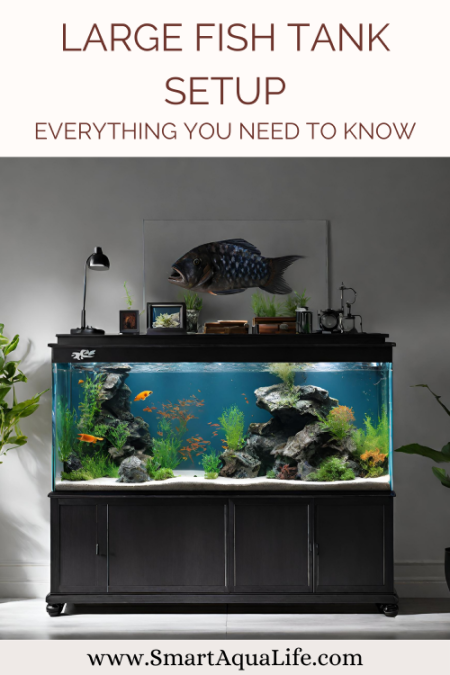
FAQs
Q: What size tank is considered large for fish keeping?
A: Large fish tanks typically start at around 55 gallons or more, providing ample space for a variety of fish species.
Q: How often should I clean my large fish tank?
A: It’s recommended to perform partial water changes and substrate vacuuming every 2-4 weeks to maintain water quality and remove debris.
Q: Can I keep live plants in a large fish tank?
A: Yes, live plants not only enhance the aesthetics of your tank but also contribute to a healthier environment by oxygenating the water and absorbing excess nutrients.
Q: Do I need a heater for my large fish tank?
A: In most cases, yes. A heater is essential for maintaining stable water temperatures, especially for tropical fish species that require warmer water.
Q: How long does it take to cycle a large fish tank?
A: The cycling process typically takes 4-6 weeks, during which beneficial bacteria establish themselves in the tank to break down harmful ammonia and nitrite compounds.

